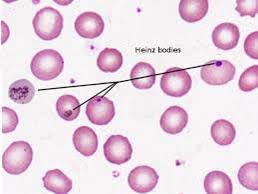
Heinz bodies are abnormal inclusions found in red blood cells, that consist of denatured hemoglobin.
These structures form as a result of oxidative damage to hemoglobin, leading to the formation of aggregates within the cell.
Heinz bodies are usually removed from red blood cells by the spleen as part of the body’s defense mechanisms against damaged cells.
Conditions that can predispose individuals to the formation of Heinz bodies: enzyme deficiencies (e.g., glucose-6-phosphate dehydrogenase deficiency), exposure to certain drugs or chemicals, or certain types of anemias.
Heinz bodies can lead to hemolysis, potentially resulting in anemia.
The presence of Heinz bodies in red blood cells can be identified microscopically using special stains like crystal violet.
Heinz bodies are not visible with routine blood staining techniques, but can be seen with supravital staining.
The presence of Heinz bodies is classically observed in G6PD deficiency, a genetic disorder that causes hemolytic anemia.
Heinz bodies appear as small round inclusions within the red cell body.
They are not visible when stained with Romanowsky dyes.
They are visualized more clearly with supravital staining: new methylene blue, crystal violet or bromocresol green.
Heinz bodies are formed by damage to the hemoglobin component through oxidative damage by administered drugs, or from an inherited mutation.
Pathophysiologically an electron from the hemoglobin is transferred to an oxygen molecule, which creates a reactive oxygen species (ROS) that can cause severe cell damage leading to premature cell lysis.
Subsequently damaged cells are cleared by macrophages in the spleen, where the precipitate and damaged membrane are removed, leading to characteristic “bite cells”.
The denaturing process is irreversible.
The continual elimination of damaged cells leads to Heinz body anemia.
Pathways that lead to the hemoglobin damage:
NADPH deficiency can cause a dysfunction in glutathione peroxidase which is an enzyme that converts hydrogen peroxide, a reactive oxygen species, into water.
G6PD (glucose-6-phosphate dehydrogenase) deficiency exacerbated by administration of oxidant drugs (e.g., primaquine, dapsone, quinidine) can also result in Heinz bodies.
G6PD deficient red cells in combination with high levels of oxidants causes a cross-linking of sulfhydryl groups on globin chains which causes a denaturing and formation of Heinz bodies.
Heinz bodies can also be found in chronic liver disease, and alpha thalassemia.
Alpha thalassemia patients have partial or complete defects in alpha globin production, leading to a relative abundance of beta globin chains in the cell.
The excess beta globin chains aggregate to form HbH, which has decreased solubility and precipitates in the red blood cell cytoplasm, due to a perturbation in the quaternary structure of hemoglobin.
The presence of Heinz bodies may also be a feature of hyposplenism/asplenia, when a damaged or absent spleen cannot remove these damaged cells from circulation.
There is no specific treatment for Heinz bodies; however, they are important as a diagnostic indicator for the causative conditions as noted above.
